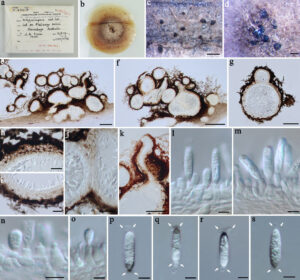Acrocalymma medicaginis Alcorn & J.A.G. Irwin, Trans. Br. Mycol. Soc. 88(2): 163 (1987)
Index Fungorum number: IF 130085;Facesoffungi number: FoF 07099
Caulicolous, corticolous on Medicago saliva (Fabaceae). Sexual morph: Undetermined. Asexual morph: Conidiomata dark brown to black, solitary to gregarious or confluent, immersed to semi-immersed, stromatic, pycnidial, globose to subglobose, pyriform or irregular in shape, multilocular or unilocular, with locule 125–390 μm diam., 225–475 μm high, often convoluted and irregularly divided, glabrous, thick-walled, with rounded or cylindrical, sinuate neck, ostiolate. Ostiole 95–280 × 65–120 μm, circular, cylindrical, straight or curved, centrally or laterally located. Conidiomatal wall 23–60 μm wide, composed two cell types; (a) outer layers of textura globosa to textura angularis, with dark brown to brown, thick-walled cells; (b) inner and middle layers of textura angularis to textura prismatica with pale brown to hyaline, thick-walled cells. Conidiophores reduced to conidiogenous cells arising all around the cavity of conidiomata. Conidiogenous cells 4–9 × 3–6 μm, hyaline, enteroblastic, phialidic, determinate, ampulliform to subcylindrical or lageniform, with a moderate periclinal thickening in collarette zone. Conidia 13–19 × 4–6 μm ( ̄x = 17 × 5 μm; n = 30), hyaline, cylindrical to fusiform, with a rounded or obtuse apex and a narrow truncate base, straight, aseptate or 1–2-septate, not constricted at septa, thick and smooth-walled, bearing helmet-shaped, mucoid appendage at both ends.
Material examined – Australia, Queensland, Hermitage, on PDA, 21 March 1972–17 April 1972, J.A.G. Irwin (IMI 165613, ex-isotype).

Figure 1. Acrocalymma medicaginis (IMI 165613, ex-isotype) a, b Herbarium specimen. c, d Appearance of dark brown to black conidiomata on the host. e, f, g Vertical sections of conidiomata. h, i, j Section of peridium. k Ostiole note k is examined in lactic acid. l, m, n, o Conidiogenous cells and developing conidia. p, q, r, s Conidia with mucoid appendages (arrows). Scale bars c = 1000 μm, d = 200 μm, e–f = 200 μm, g = 100 μm, h–j = 25 μm, k = 100 μm, l–s = 5 μm.
